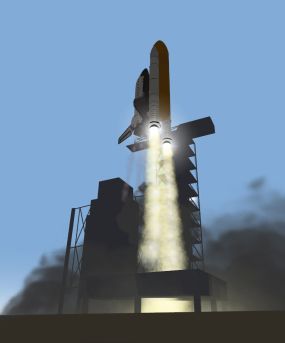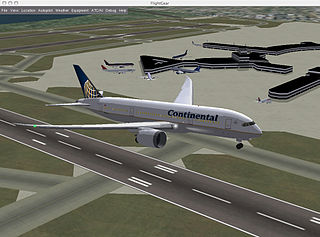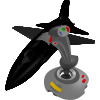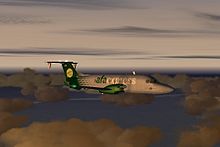Racing games are a video game genre in which the player participates in a racing competition. They may be based on anything from real-world racing leagues to fantastical settings. They are distributed along a spectrum between more realistic racing simulations and more fantastical arcade-style racing games. Kart racing games emerged in the 1990s as a popular sub-genre of the latter. Racing games may also fall under the category of sports video games.
Simulation video games are a diverse super-category of video games, generally designed to closely simulate real world activities. A simulation game attempts to copy various activities from real life in the form of a game for various purposes such as training, analysis, prediction, or entertainment. Usually there are no strictly defined goals in the game, and the player is allowed to control a character or environment freely. Well-known examples are war games, business games, and role play simulation. From three basic types of strategic, planning, and learning exercises: games, simulations, and case studies, a number of hybrids may be considered, including simulation games that are used as case studies. Comparisons of the merits of simulation games versus other teaching techniques have been carried out by many researchers and a number of comprehensive reviews have been published.

Orbiter is a space flight simulator program developed to simulate spaceflight using realistic Newtonian physics. The simulator was released on 27 November 2000; the latest edition, labeled "Orbiter 2024", was released on 31 December 2024. On 27 July 2021, its developer, Martin Schweiger, announced to the community that Orbiter is being published under open source MIT License.

Simulated racing or racing simulation, commonly known as simply sim racing, are the collective terms for racing game software that attempts to accurately simulate auto racing, complete with real-world variables such as fuel usage, damage, tire wear and grip, and suspension settings. To be competitive in sim racing, a driver must understand all aspects of car handling that make real-world racing so difficult, such as threshold braking, how to maintain control of a car as the tires lose traction, and how properly to enter and exit a turn without sacrificing speed. It is this level of difficulty that distinguishes sim racing from arcade racing-style driving games where real-world variables are taken out of the equation and the principal objective is to create a sense of speed as opposed to a sense of realism like the Need for Speed series.

Driving simulators are used for entertainment as well as in training of driver's education courses taught in educational institutions and private businesses. They are also used for research purposes in the area of human factors and medical research, to monitor driver behavior, performance, and attention and in the car industry to design and evaluate new vehicles or new advanced driver assistance systems.
The following outline is provided as an overview of and topical guide to video games:
Combat flight simulators are vehicle simulation games, amateur flight simulation computer programs used to simulate military aircraft and their operations. These are distinct from dedicated flight simulators used for professional pilot and military flight training which consist of realistic physical recreations of the actual aircraft cockpit, often with a full-motion platform.

A motion simulator or motion platform is a mechanism that creates the feelings of being in a real motion environment. In a simulator, the movement is synchronised with a visual display of the outside world (OTW) scene. Motion platforms can provide movement in all of the six degrees of freedom (DOF) that can be experienced by an object that is free to move, such as an aircraft or spacecraft:. These are the three rotational degrees of freedom and three translational or linear degrees of freedom.

Grand Prix 2, released in North America as "Grand Prix II", is a racing simulator released by MicroProse in 1996. It is a sequel to Formula One Grand Prix. It was made under an official FIA license that featured the Formula One 1994 season, with all of the circuits, teams, drivers and cars. The cars were painted with liveries reflecting the races that did not allow tobacco and alcohol sponsors.

rFactor is a computer racing simulator designed for hardcore simulation racers. rFactor claimed to be the most accurate race simulator of its time. Released in August 2005, it competed with games like Nascar 2003, Live for Speed, and GTR. The game featured many technical advances in tire modeling, complex aerodynamics and a 15 degrees of freedom physics engine. It also featured multiplayer.

Life simulation games form a subgenre of simulation video games in which the player lives or controls one or more virtual characters. Such a game can revolve around "individuals and relationships, or it could be a simulation of an ecosystem". Other terms include artificial life game and simulated life game (SLG).

Rig'n'Roll is an open world truck driving simulation and racing video game released on 27 November 2009 in Russia and during 2010 in the rest of the world. It simulates truck driving and management along with associated business strategic activities, and features North American trucks. The game takes place in California and Nevada, in the year 2014.
Construction and management simulation (CMS), sometimes also called management sim or building sim, is a subgenre of simulation game in which players build, expand or manage fictional communities or projects with limited resources. Strategy video games sometimes incorporate CMS aspects into their game economy, as players must manage resources while expanding their project. Pure CMS games differ from strategy games, however, in that "the player's goal is not to defeat an enemy, but to build something within the context of an ongoing process." Games in this category are sometimes also called "management games".

In video games, first-person is any graphical perspective rendered from the viewpoint of the player character, or from the inside of a device or vehicle controlled by the player character. It is one of two perspectives used in the vast majority of video games, with the other being third-person, the graphical perspective from outside of any character ; some games such as interactive fiction do not belong to either format.
Space flight simulation is a genre of flight simulator video games that lets players experience space flight to varying degrees of realism. Common mechanics include space exploration, space trade and space combat.

A flight simulation video game refers to the simulation of various aspects of flight or the flight environment for purposes other than flight training or aircraft development. A significant community of simulation enthusiasts is supported by several commercial software packages, as well as commercial and homebuilt hardware. Open-source software that is used by the aerospace industry like FlightGear, whose flight dynamics engine (JSBSim) is used in a 2015 NASA benchmark to judge new simulation code to space industry standards, is also available for private use. A popular type of flight simulators video games are combat flight simulators, which simulate combat air operations from the pilot and crew's point of view. Combat flight simulation titles are more numerous than civilian flight simulators due to variety of subject matter available and market demand.
Simraceway was an online racing simulation that hosted live, multiplayer racing events. The race environment was developed by Ignite Game Technologies, Inc. The service used a client-server software model similar to popular online games such as World of Warcraft allowing the racing environment to be continually updated.

A kart racing game, also known as cart racing game or go-kart racing game, is a subgenre of racing games. Kart racing games have simplified driving mechanics while including unusual racetrack designs, obstacles, and vehicular combat. Though the genre has its roots in the 1980s, Super Mario Kart (1992) popularized the genre, with the Mario Kart series still being considered the foremost kart racing franchise.

Automobilista 2 is a motorsport racing simulator game created by Reiza Studios, under the lead of Renato Simioni. The game was initially released as an Early Access title on March 31, 2020, via Steam, with the official V1.0 release taking place on June 30, 2020. Automobilista 2 features a wide variety of cars and tracks. Its main focus is on Brazilian content, which includes licensed Brazilian racing series such as Stock Car Brazil and Copa Truck. There is also an emphasis on Formula racing cars of many different eras, and includes licensed and generic vehicles. Other racing classes represented in Automobilista 2 include, but are not limited to: Retro touring cars, 1990s American open-wheel cars, GT3 and karts. Automobilista 2 supports VR, triple screen and full motion racing simulator setups.













